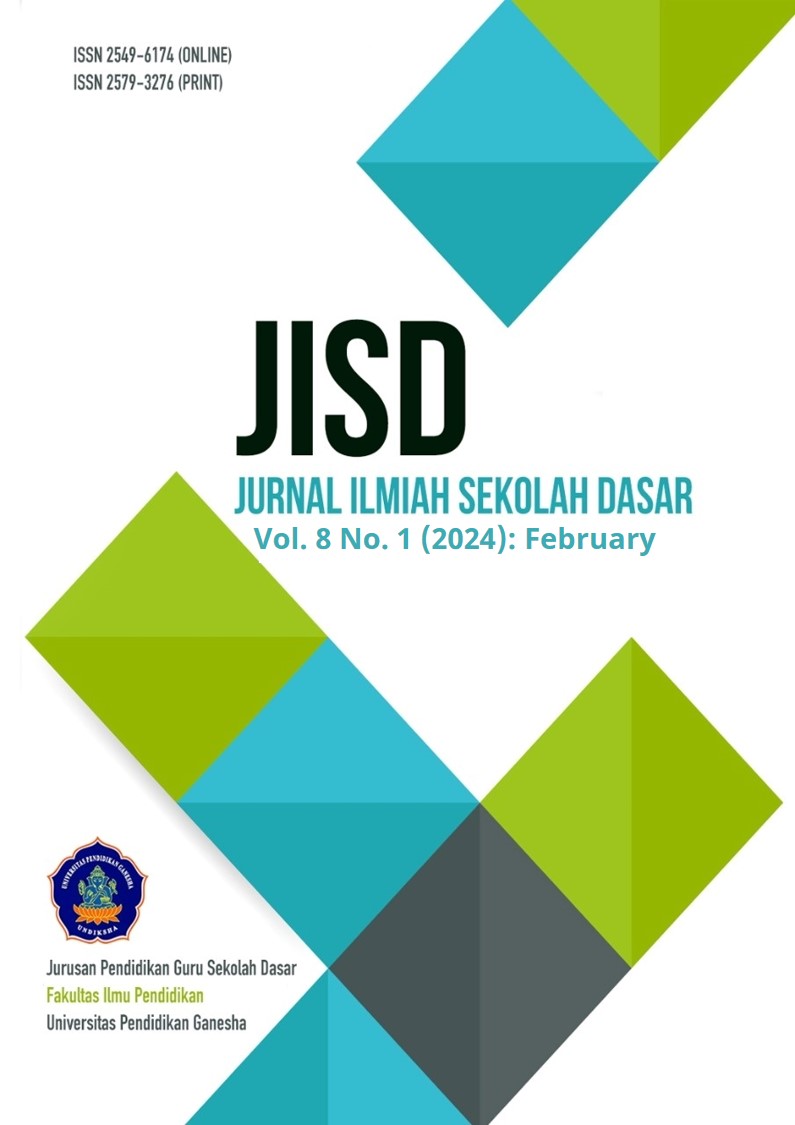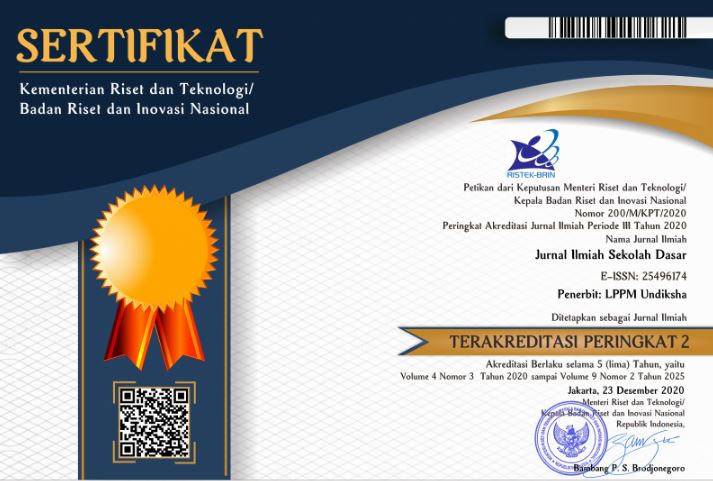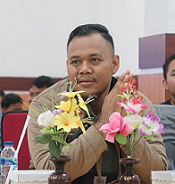Digital Storytelling Animation Media with Minimum Competency Assessment to Enhancing Students Folktales Reading Comprehension
DOI:
https://doi.org/10.23887/jisd.v8i1.67243Keywords:
Learning Media, Digital Storytelling, Minimum Competency Assessment, Reading Comprehension CompetencyAbstract
This research is motivated by observational data indicating the low learning outcomes of second-grade students in the competency of reading to folktales, which is attributed to the limited use of media in teaching. Therefore, this research aims to developed an instructional tool: digital animation storytelling media with Minimum Competency Assessment (MCA). The research method employed in this study was Research and Development (R&D), utilizing the ADDIE model. This study involved a class teacher and 26 learners in grade II of an Elementary School. The primary objective of this research was to analyze the feasibility and effectiveness of the digital animation storytelling media with MCA for the second-grade class in enhancing the competency of reading to folktales. Data were collected using a questionnaire to assess media feasibility and pretest-posttest questionnaires to measure the media's effectiveness. The results of the media feasibility assessment, based on the questionnaire, obtained a percentage of 90%, indicating "Very Feasible" according to content experts, while media experts rated it at 84%, indicating "Eligible." Regarding the effectiveness of the media, as assessed through pretest-posttest questionnaires, the N-Gain test revealed an average improvement of 0.48 on a small scale with an average difference of 22.5. Based on these findings, it can be concluded that the digital animation storytelling media with MCA for the second-grade class is not only suitable for instructional use but also effectively enhances students' learning outcomes in the competency of reading to folktales.
References
Agami, S. F. (2023). Pengaruh Penggunaan Media Animasi Terhadap Keterampilan Menceritakan Kembali Isi Fabel Siswa Kelas VII Smp Negeri 2 Sijunjung Ta 2022/2023. Jurnal Bahasa, Sastra, Dan Pengajaran, 2(2), 262–270. https://doi.org/10.58218/alinea.v2i2.230. DOI: https://doi.org/10.58218/alinea.v2i2.230
Aini, S. N., & Pramasdyahsari, A. S. (2023). Pendampingan Simulasi Asesmen Kompetensi Minimum Berbasis Literasi Digital Untuk Meningkatkan Kemampuan Literasi Numerasi Dan Adaptasi Teknologi Siswa Sekolah Dasar. Jurnal Pengabdian Masyarakat Bangsa, 1(6), 573–583. https://doi.org/10.59837/jpmba.v1i6.210. DOI: https://doi.org/10.59837/jpmba.v1i6.210
Al Mamun, M. A., Lawrie, G., & Wright, T. (2022). Exploration of learner-content interactions and learning approaches: The role of guided inquiry in the self-directed online environments. Computers & Education, 178, 104398. https://doi.org/10.1016/j.compedu.2021.104398. DOI: https://doi.org/10.1016/j.compedu.2021.104398
Ali, M. (2020). Pembelajaran Bahasa Indonesia Dan Sastra (Basastra) Di Sekolah Dasar. PERNIK : Jurnal Pendidikan Anak Usia Dini, 3(1), 35–44. https://doi.org/10.31851/pernik.v3i2.4839. DOI: https://doi.org/10.31851/pernik.v3i2.4839
Amalia, I. N. (2022). Improving Learning Interest Of Elementary School Students Through Indonesian Language Learning Animation Videos. International Journal Of Elementary School, 6(3), 664–671. https://doi.org/10.23887/ijee.v6i4.47423.
Andriani, E. Y. (2019). Pengembangan Media Pembelajaran Video Animasi Dan Hasil Belajar Di Sekolah Dasar. Universitas Sultan Ageng Tirtayasa, 6(1). http://jurnal.untirta.ac.id/index.php/JTPPm/article/view/7409.
Anggraini, D., Khumaedi, M., & Widowati, T. (2020). Validity and reliability contents of independence assessment instruments of basic beauty students for class X SMK. Journal of Research and Educational Research Evaluation, 9(1), 40–46. https://doi.org/10.15294/jere.v9i1.42558. DOI: https://doi.org/10.15294/jere.v9i1.42558
Asdianti, S., Khaeruddin, K., & Hambali, H. (2022). Pengaruh Penggunaan Media Pembelajaran Film Animasi Terhadap Hasil Belajar Siswa Di Kelas Iv Sdi Bertingkat Labuang Baji. Indonesian Journal Of Social And Educational Studies, 3(1), 40–50. https://doi.org/10.26858/Ijses.V3i1.37040. DOI: https://doi.org/10.26858/ijses.v3i1.37040
Cahya, W. I., Sutansi, & Muzaki, F. I. (2019). Peningkatan Hasil Belajar Menggali Informasi Dari Dongeng Binatang Melalui Media Audio Visual Di Sekolah Dasar. Wahana Sekolah Dasar, 27(2), 73–79. http://download.garuda.kemdikbud.go.id/article.php?article=1761409&val=15282&title.
Dewi, N. A. (2022). Pengembangan Media Buku Dongeng Digital Untuk Keterampilan Menyimak Siswa Kelas Iii Di Sdn Cilenggang 02. Nadia, 6(1), 38–54. https://doi.org/10.32507/attadib.v6i2.1298
Elmahdi, I., Al-Hattami, A., & Fawzi, H. (2018). Using Technology for Formative Assessment to Improve Students’ Learning. Turkish Online Journal of Educational Technology-TOJET, 17(2), 182–188. https://eric.ed.gov/?id=EJ1176157.
Fatmawati, N. L. (2021). Pengembangan Video Animasi Powtoon Sebagai Media Pembelajaran Bahasa Inggris Usia Sekolah Dasar di Masa Pandemi. INSANIA : Jurnal Pemikiran Alternatif Kependidikan, 26(1), 65–77. https://doi.org/10.24090/insania.v26i1.4834. DOI: https://doi.org/10.24090/insania.v26i1.4834
Fortinasari, P. B., Anggraeni, C. W., & Malasari, S. (2022). Digital Storytelling Sebagai Media Pembelajaran Kreatif. Aptekmas Jurnal Pengabdian Kepada Masyarakat, 5(1), 24–32. https://doi.org/10.30651/aks.v7i4.15026. DOI: https://doi.org/10.30651/aks.v7i4.15026
Fu, J. S., Yang, S. H., & Yeh, H. C. (2022). Exploring the impacts of digital storytelling on English as a foreign language learners’ speaking competence. Journal of Research on Technology in Education, 54(5), 679–694. https://doi.org/10.1080/15391523.2021.1911008. DOI: https://doi.org/10.1080/15391523.2021.1911008
Handrianto, C., Rasool, S., Rahman, M. A., Musta`in, M., & Ilhami, A. (2021). Teachers` Self-Efficacy and Classroom Management in Community Learning Centre (CLC) Sarawak. SPEKTRUM: Jurnal Pendidikan Luar Sekolah (PLS), 9(2), 154. https://doi.org/10.24036/spektrumpls.v9i2.111963. DOI: https://doi.org/10.24036/spektrumpls.v9i2.111963
Hapsari, G. P. P., & Zulherman, Z. (2021). Pengembangan media video animasi berbasis aplikasi canva untuk meningkatkan motivasi dan prestasi belajar siswa. Jurnal Basicedu, 5(4), 2384–2394. https://doi.org/10.31004/basicedu.v5i4.1237. DOI: https://doi.org/10.31004/basicedu.v5i4.1237
Iswara, H. S., Ahmadi, F., & Ary, D. Da. (2022). Numeracy Literacy Skills of Elementary School Students through Ethnomathematics-Based Problem Solving. Interdisciplinary Social Studies, 2(2), 1604–1616. https://doi.org/10.55324/iss.v2i2.316. DOI: https://doi.org/10.55324/iss.v2i2.316
Krisanti, R. Y., Suprihatien, S., & Suryarini, D. Y. (2020). Pengembangan Media Pembelajaran Boneka Tangan Mata Pelajaran Bahasa Indonesia Materi Menyimak Dongeng Pada Siswa Kelas Ii Sekolah Dasar. Trapsila: Jurnal Pendidikan Dasar, 2(02), 24. https://doi.org/10.30742/Tpd.V2i2.918. DOI: https://doi.org/10.30742/tpd.v2i2.918
Krüger, J. M., & Bodemer, D. (2022). Application and Investigation of Multimedia Design Principles in Augmented Reality Learning Environments. Information (Switzerland), 13(2). https://doi.org/10.3390/info13020074. DOI: https://doi.org/10.3390/info13020074
Kurniati, A., Oktaviani, U. D., & Thomas, J. (2022). Digitalisasi Dongeng Nusantara Sebagai Alternatif Media Pembelajaran Era Digital Di Tingkat Sekolah Dasar. Jurnal Pendidikan Dasar Perkhasa, 8(2), 173–181. https://doi.org/10.31932/jpdp.v8i2.1964. DOI: https://doi.org/10.31932/jpdp.v8i2.1964
Kusumawati, L. D., Sugito, Nf., & Mustadi, A. (2021). Kelayakan Multimedia Pembelajaran Interaktif Dalam Memotivasi Siswa Belajar Matematika. Kwangsan: Jurnal Teknologi Pendidikan, 9(1), 31. https://doi.org/10.31800/jtp.kw.v9n1.p31--51. DOI: https://doi.org/10.31800/jtp.kw.v9n1.p31--51
Lei, W., Zhang, H., Deng, W., Wang, H., Shao, F., & Hu, W. (2021). Academic self-efficacy and test anxiety in high school students: A conditional process model of academic buoyancy and peer support. Sage Journal: School Psychology International, 1–10. https://doi.org/10.1177/01430343211039265. DOI: https://doi.org/10.1177/01430343211039265
Nabella, M. (2022). Pengembangan Vidio Pembelajaran Berbasis Software Adobe Premiere Pro Dalam Meningkatkan Kemampuan Menyimak Dongeng Mata Pelajaran Bahasa Indonesia. Efektor, 9(1), 143–154. https://doi.org/10.29407/E.V9i1.16358. DOI: https://doi.org/10.29407/e.v9i1.16358
Nathalia Angelina, G., Ganing, N. N., & Kristiantari, M. R. (2021). Pengembangan Media Video Animasi Berorientasi Membaca Pemahaman Dengan Strategi Directed Reading Thinking Activity (Drta) Pada Muatan Bahasa Indonesia. Jurnal Penelitian Dan Pengembangan Pendidikan, 5(1), 100–108. https://ejournal.undiksha.ac.id/Index.Php/Jjl/Article/View/32453.
Nurani, R. Z., Nugraha, F., & Sidik, G. S. (2018). Penggunaan Media Audio Visual Dalam Pembelajaran Menyimak Dongeng Di Era Digital. Eduhumaniora | Jurnal Pendidikan Dasar Kampus Cibiru, 10(2), 78. https://doi.org/10.17509/Eh.V10i2.10867. DOI: https://doi.org/10.17509/eh.v10i2.10867
Nuroh, E. Z., & Frestiya Adiyawati, F. (2023). The Influence Of Digital Storytelling On Story Writing Skills Of Class Ii Elementary School Students. Jurnal Pendidikan Dasar Nusantara, 8(2), 357–369. https://doi.org/10.29407/Jpdn.V8i2.18582. DOI: https://doi.org/10.29407/jpdn.v8i2.18582
Purnomo, H., Sa’dijah, C., Hidayanto, E., Sisworo, S., Permadi, H., & Anwar, L. (2022). Development of instrument numeracy skills test of minimum competency assessment (MCA) in Indonesia. International Journal of Instruction, 15(3), 635–648. https://doi.org/10.29333/iji.2022.15335a. DOI: https://doi.org/10.29333/iji.2022.15335a
Rahiem, M. D. H. (2021). Storytelling in early childhood education: Time to go digital. International Journal of Child Care and Education Policy, 15(1). https://doi.org/10.1186/s40723-021-00081-x. DOI: https://doi.org/10.1186/s40723-021-00081-x
Ratnaningsih, A. S., & Jatibaru, S. (2021). Peningkatan Keterampilan Menyimak Dongeng Melalui Model Paire Storytelling Dengan Media Wayang Kartun Pada Siswa Kelas Ii Semester Ganjil Sdn Jatibaru Kecamatan Saguling Kabupaten Bandung Barat. Collase (Creative Of Learning Students Elementary Education, 4(6), 943–950. //www.journal.ikipsiliwangi.ac.id/Index.Php/Collase/Article/View/9657. DOI: https://doi.org/10.22460/collase.v4i6.9657
Rosadi, A. F., Nurhalizah, F., Kusumawardani, S., & Marini, A. (2023). Implementasi Nilai Pendidikan Karakter Pada Siswa Kelas 2 Sd Berbasis Digital Storytelling: Implementasi Nilai Pendidikan Karakter Pada Siswa Kelas 2 Sd Berbasis Digital Storytelling. Jurnal Pendidikan Dasar Dan Sosial Humaniora, 2(3), 413–420. https://bajangjournal.com/index.php/JPDSH/article/download/4468/3560.
Sadiman. (2018). Media Pendidikan : Pengertian, Pengembangan, Dan Pemanfaatannya (Cetakan Ke. Raja Grafindo Persada.
Sagri, M., Sofos, F., & Mouzaki, D. (2018). Digital Storytelling, comics and new technologies in education: Review, research and perspectives. International Education Journal, 17(4), 97–112. https://openjournals.library.sydney.edu.au/IEJ/article/view/12485.
Saputri, D. Y., Rukayah, R., & Indriayu, M. (2018). Need Assessment of Interactive Multimedia Based on Game in Elementary School: A Challenge into Learning in 21st Century. International Journal of Educational Research Review, 3(3), 1–8. https://doi.org/10.24331/ijere.411329. DOI: https://doi.org/10.24331/ijere.411329
Septikasari, R., & Frasandy, R. (2018). Keterampilan 4C Abad 21 Dalam Pembelajaran Pendidikan Dasar. Jurnal Tarbiyah Al Awlad, VIII, 107–117. https://doi.org/10.15548/alawlad.v8i2.1597.
Sugiyono, D. (2022). Metode Penelitian Kuatintatif (K. D. R & D. (eds.)).
Sumarni, R. A., Bhakti, Y. B., Astuti, I. A. D., Sulisworo, D., & Toifur, M. (2020). The Development of Animation Videos Based Flipped Classroom Learning on Heat and Temperature Topics. Indonesian Journal of Science and Mathematics Education, 3(3), 304–315. https://doi.org/10.24042/ijsme.v3i2.7017. DOI: https://doi.org/10.24042/ijsme.v3i3.7017
Syaifuddin, M. (2022). Minimum Competency Assessment to Measure Mathematical Literacy of Junior High School Students. Journal of Education Research and Evaluation, 6(2), 316–326. https://doi.org/10.23887/jere.v6i2.46263. DOI: https://doi.org/10.23887/jere.v6i2.46263
Tahmidaten, L. (2021). Project-based Learning Untuk Mengembangkan Kompetensi 4C: Implementasinya Pada Pembelajaran Sosiologi SMA. Jurnal Sikola: Jurnal Kajian Pendidikan Dan Pembelajaran, 3(2), 201–220. https://doi.org/10.24036/sikola.v3i2.172. DOI: https://doi.org/10.24036/sikola.v3i2.172
Torres-Gastelú, C. A., & Kiss, G. (2016). Perceptions of students towards ICT competencies at the University. Informatics in Education, 15(2), 319–338. https://doi.org/10.15388/infedu.2016.16 DOI: https://doi.org/10.15388/infedu.2016.16
Walgermo, B. R., Frijters, J. C., & Solheim, O. J. (2018). Literacy interest and reader self-concept when formal reading instruction begins. Early Childhood Research Quarterly, 44, 90–100. https://doi.org/10.1016/j.ecresq.2018.03.002. DOI: https://doi.org/10.1016/j.ecresq.2018.03.002
Widiastuti. (2023). Penggunaan Media Audio Visual Untuk Meningkatkan Keterampilan Menyimak Dongeng Pelajaran Bahasa Indonesia. Jurnal Penelitian Dan Pengabdian Masyarakat, 2(10), 2142–2152. https://doi.org/10.36418/Comserva.V2i10.633. DOI: https://doi.org/10.59141/comserva.v2i10.633
Wisada, P. D., Sudarma, I. K., & Yuda S, A. I. W. I. (2019). Pengembangan Media Video Pembelajaran Berorientasi Pendidikan Karakter. Journal of Education Technology, 3(3), 140. https://doi.org/10.23887/jet.v3i3.21735. DOI: https://doi.org/10.23887/jet.v3i3.21735
Wulandari, S. (2020). Pengaruh Penggunaan Metode Drill Terhadap Kemampuan Menggali Informasi Dari Dongeng Peserta Didik Kelas Ii Sekolah Dasar. Journal Of Basic Education Research, 1(1), 01–06. https://doi.org/10.37251/Jber.V1i1.6. DOI: https://doi.org/10.37251/jber.v1i1.6
Yamtinah, S., Utami, B., Masykuri, M., Mulyani, B., Ulfa, M., & Shidiq, A. S. (2022). Secondary School Science Teacher Response to Minimum Competency Assessment: Challenges and Opportunities. Jurnal Penelitian Pendidikan IPA, 8(1), 124–131. https://doi.org/10.29303/jppipa.v8i1.1075. DOI: https://doi.org/10.29303/jppipa.v8i1.1075
Downloads
Published
How to Cite
Issue
Section
License
Copyright (c) 2024 Auliya Nurul Faizah

This work is licensed under a Creative Commons Attribution-ShareAlike 4.0 International License.
Authors who publish with the Journal Ilmiah Sekolah Dasar agree to the following terms:
- Authors retain copyright and grant the journal the right of first publication with the work simultaneously licensed under a Creative Commons Attribution License (CC BY-SA 4.0) that allows others to share the work with an acknowledgment of the work's authorship and initial publication in this journal.
- Authors are able to enter into separate, additional contractual arrangements for the non-exclusive distribution of the journal's published version of the work (e.g., post it to an institutional repository or publish it in a book), with an acknowledgment of its initial publication in this journal.
- Authors are permitted and encouraged to post their work online (e.g., in institutional repositories or on their website) prior to and during the submission process, as it can lead to productive exchanges, as well as earlier and greater citation of published work. (See The Effect of Open Access)










